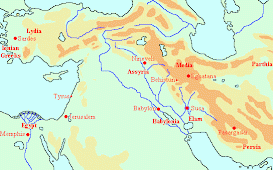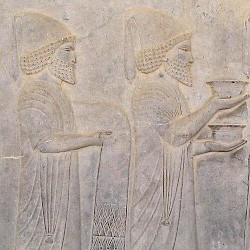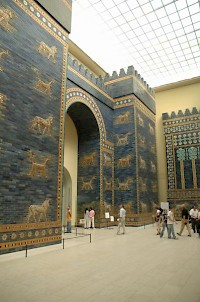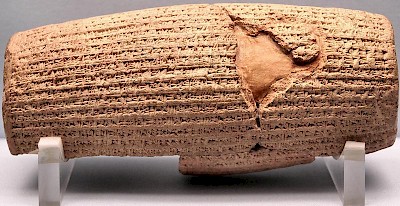Herodotus, bk 1, logos 3
Herodotus of Halicarnassus (c.480-c.429 BCE): Greek researcher, often called the world's first historian. In The Histories, he describes the expansion of the Achaemenid Empire under its kings Cyrus the Great, Cambyses, and Darius I the Great, culminating in Xerxes' expedition to Greece (480 BCE), which met with disaster in the naval engagement at Salamis and the battles at Plataea and Mycale. Herodotus' book also contains ethnographic descriptions of the peoples that the Persians have conquered, fairy tales, gossip, and legends.
Affairs in Babylonia and Persia (1.141-216)

Herodotus goes on to tell about Cyrus' adventures after his conquest of Media and Lydia. After his capture of Sardes (above), the cities of the Ionian Greeks, which were subject to Croesus, send embassies to prevent war, and the Spartans announce that they will support the Ionians. (At this point, Herodotus interrupts his narrative to digress on the towns of these Greek settlers in Asia.) Cyrus ignores these embassies and returns to Media to defend the eastern provinces of his empire against the Scythians (below); Cyrus' friend Harpagus (above) makes quick work of the Ionian Greeks and the Lydians, who have revolted.
This Lydian revolt causes a short discussion between Cyrus and Croesus. Cyrus asks the former ruler of Lydia what to do. Croesus advises the great king to make sure that the Lydians forget how to fight and learn more peaceful arts. Soon, they will succumb to luxury and no longer be a threat. Cyrus recognizes that this is a sound advice.

Cyrus now rules a large kingdom, stretching from the Greek towns on the shores of the Aegean Sea to the Persian Gulf in the south. Now he prepares to attack his former ally, king Labynetus of Babylonia. Herodotus gives a long description of its capital Babylon. Cyrus defeats the Babylonian troops and lays siege to their city; he is able to take it by directing the river Euphrates in another direction - when the water is shallow enough, his soldiers enter the city through the former water course. The Babylonians are surprised and surrender. (Go here for a translation of the story of Cyrus' campaign against Babylon.)
After a digression on Babylonian customs, Herodotus describes Cyrus' campaign against the Massagetes, a nomadic tribe in modern Uzbekistan. Although Cyrus' adviser Croesus tries to dissuade the Persian king from attacking his enemy, his advise is ignored, and the Massagetian queen Tomyris defeats and kills Cyrus. This logos ends with a short appendix in which Herodotus informs us about the customs of the Massagetes.
Comment

King Labynetus is identical with Nabonidus, but that is about all we can say for Herodotus' credibility. Contemporary cuneiform texts inform us about the Babylonian side of the story: Nabonidus was afraid of the growing Persian power and spent much time finding allies in Arabia. Meanwhile, he was absent from Babylon, an absence that its inhabitants did not appreciate. The Chronicle of Nabonidus (year seventeen) informs us that Cyrus defeated the Babylonian army in the neighborhood of modern Baghdad on 10 October 539 BCE. Two days later, his commander-in-chief "Ugbaru" entered Babylon and had Nabonidus captured. (His Persian name was Gaubaruva, a name that is usually translated into Greek as Gobryas.) Cyrus entered the city a few days later; his own story is told in the Cyrus Cylinder. The event is well known from the Bible, because Cyrus allowed the exiled Jews to return home.note

Herodotus' description of the city is nonsensical (go here for a better description). For example, he wants us to believe that the walls of Babylon are 100 meters high and 22 kilometers long; hundred bronze gates give access to the city. The famous English historian Edward Gibbon (1737-1794) was one of the first to remark that Herodotus never set foot in the old city - causing a bitter polemic among the believers and skeptics which lasts until the present day. Probably, Gibbon was right and Herodotus had no access to Babylonian information.
Cuneiform texts enable us to date Cyrus death in December 530. He was succeeded by his son Cambyses.